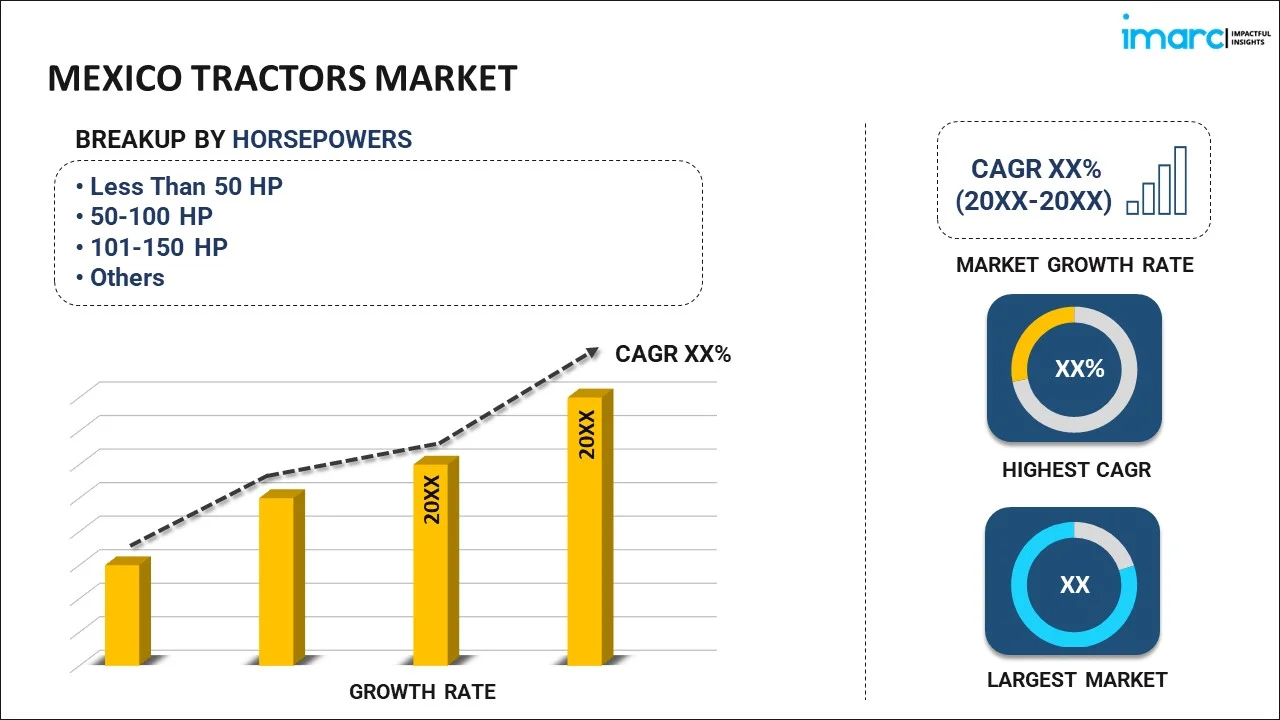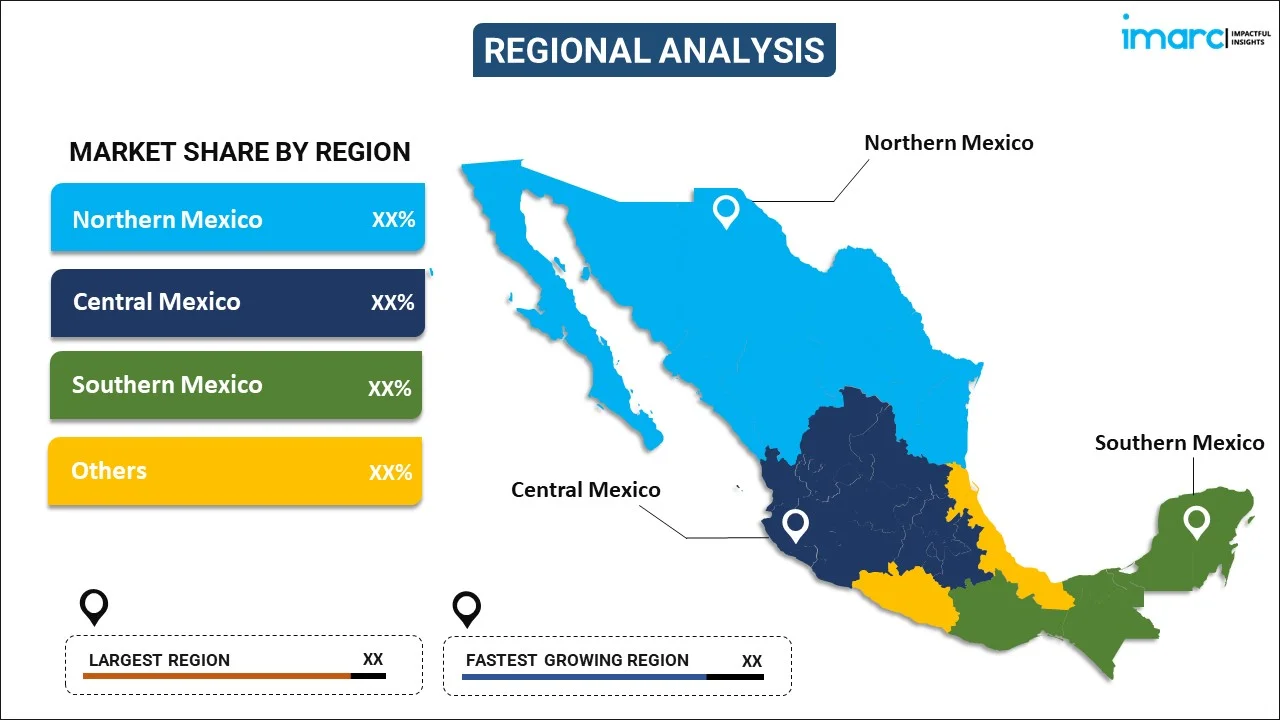
Mexico Tractors Market Report by Horsepower (Less Than 50 HP, 50-100 HP, 101-150 HP, 151-250 HP, Above 250 HP), Wheel Drive (2-Wheel-Drive, 4-Wheel-Drive), and Region 2025-2033
Mexico Tractors Market Size, Share & Analysis
Mexico tractors market size reached USD 641.7 Million in 2024. The market is projected to reach USD 953.7 Million by 2033, exhibiting a growth rate (CAGR) of 4.10% during 2025-2033. The Mexican tractors market is experiencing strong growth with increasing mechanization of small and medium farm holdings, growing adoption of precision farming technologies, and expanding government support in the form of subsidies. There is an escalating demand for utility and compact tractors as a result of their ability to traverse different types of terrains and high efficiency levels. Local assembly enhanced after-sales services, and the launch of technologically superior models are also supporting market dynamics. These in turn are responsible for the growing Mexico tractors market share.
|
Report Attribute
|
Key Statistics
|
|---|---|
|
Base Year
|
2024 |
|
Forecast Years
|
2025-2033
|
|
Historical Years
|
2019-2024
|
| Market Size in 2024 | USD 641.7 Million |
| Market Forecast in 2033 | USD 953.7 Million |
| Market Growth Rate (2025-2033) | 4.10% |
Tractors are powerful agricultural vehicles designed to perform a variety of tasks, revolutionizing modern farming practices. Typically equipped with large, rugged tires and a robust engine, tractors are essential for tasks such as plowing, planting, and harvesting crops. They can also be used for hauling heavy loads, making them versatile machines on the farm. Tractors often feature attachments like plows, seeders, and harrows, enhancing their functionality and efficiency. In addition to traditional farming, tractors play a crucial role in construction, forestry, and other industries. Their development has significantly increased the productivity and scale of agricultural operations, enabling farmers to cultivate larger areas and meet the demands of a growing population. With continuous advancements in technology, modern tractors may incorporate GPS systems and automated features, further improving precision and reducing the labor required for various tasks.
Mexico Tractors Market Trends:
Mechanization of Small and Medium-Sized Farms
The Mexican agricultural industry has experienced a growing trend towards mechanization, particularly on small and medium-sized farms. Historically dependent on manual labor or minimal tools, farmers are increasingly implementing tractors to enhance productivity, save time and labor expenses, and respond to increasing demand for farm produce. Government initiatives in promoting rural development and providing subsidies or loans for the purchase of machinery have also furthered Mexico tractors market trends. Utility tractors and compact ones are in high demand, as they are best adaptable to the diverse terrain and smaller holdings prevalent in most areas. Increasing labor shortages and a need for efficiency of operations are also driving farmers to mechanize. This transition is not only generating domestic tractor sales but also generating demand for specialty, multi-purpose tractors suited to a range of farming activities—ranging from plowing and sowing to crop protection and post-harvest management. For instance, in November 2023, FOTON Mexico introduced its Galaxy tractor-trailer with Euro V engine, 360º cameras, LED lights, and touchscreen panel and set a target to sell more than 12,000 units by 2024.
Integration of Precision Agriculture Technologies
According to Mexico tractors market analysis, tractor manufacturers are increasingly upfitting their tractors with precision agriculture capabilities, meeting the industry's demand for higher efficiency and sustainability. Technologies like GPS-steering, variable rate technology (VRT), and telematics are making inroads, particularly with commercial farms producing export-oriented crops such as avocados, berries, and corn. These new features enable farmers to better manage input use—seeds, fertilizers, and pesticides—in response to varying crop conditions while reducing environmental footprint and increasing predictability of yields. The use of smart tractors is also favored by growing access to digital farming platforms that combine weather forecasts, soil testing, and crop health monitoring. Although high initial expenses are required, long-term advantages of resource conservation and yield improvement are promoting adoption, particularly as technology prices reduce. Additionally, younger, technologically savvy farmers and agribusiness owners increasingly are looking at tractors as intelligent machines that are crucial to contemporary agriculture rather than mere mechanical devices.
Expansion of Aftermarket Services and Local Assembly
Mexico tractors market forecast is witnessing ongoing growth in the demand for tractors, the quality and availability of aftermarket services have emerged as a major point of differentiation between brands. Farmers favor brands that have strong service networks, access to original spare parts, and quick customer service. To counter this, most global tractor makers are making investments in local service centers and dealerships to boost post-sales support. The local assembly operations are also picking up pace, allowing brands to save costs, obey trade regulations, and align tractor specifications according to the requirements of the region. These plants tend to partner with Mexican suppliers for parts, advancing the domestic production hub. The trend toward localization not only reduces lead times but also enables producers to stay competitive in price-conscious rural areas. As tractor penetration and usage intensity increase, maintenance, repair, and prompt replacement of parts are fuelling a robust aftermarket, driving rural employment and technical and mechanical skills training in services in Mexico.
Mexico Tractors Market Growth Driver:
One of the key drivers of the Mexico tractors market growth is commercial agriculture's constant expansion and modernization. As Mexico increases its export of agriculture—specifically high-value crops avocados, berries, sugarcane, and vegetables—there is a growing requirement for scalability, efficiency, and yield maximization. The commercial farms are making investments in tractors as a way of mechanizing activities like tilling, planting, spraying, and harvesting to achieve export-quality standards and rigid delivery times. Such farms tend to take up bigger pieces of land and need tractors with greater horsepower and advanced attachments and precision farming tools. The use of tractors on large-scale farming not only increases productivity but also minimizes reliance on seasonal labor, which may be unpredictable or expensive. In addition, government initiatives aimed at promoting the development of agribusiness and making it easy to access credit or subsidies on the purchase of machinery are cementing this transition. Combined, these forces are driving tractor adoption in growing commercial farm market.
Mexico Tractors Market Challenges:
High Front-End Costs
To a large number of Mexican farmers, particularly small-scale farmers, the initial high price of acquiring a tractor is a major hindrance in most cases. While there are government schemes and credit facilities, these may be intricate to access or not easily accessible for them. Without proper support from financial assistance or reasonable financing, farmers tend to postpone or forego tractorization, which consequently constrains their productivity, efficiency, and competitiveness within contemporary agricultural economies.
Broken-up Land Holdings
Mexican farm lands tend to be highly fragmented into small, dispersed parcels, especially in rural and indigenous areas. This makes it less practicable to utilize tractors effectively, given that the machinery can be too cumbersome for narrow or irregularly shaped parcels. Moreover, constant shifting between fields results in increased fuel consumption and wear. Consequently, farmers can find manual or animal-powered traditional methods easier to handle despite their inefficiency.
Limited Technical Support
Consistent access to technical know-how, spare parts, and maintenance services is inconsistent throughout Mexico, especially in rural farming communities. Farmers who acquire tractors without robust local support networks risk extended downtimes during peak farming periods. This unavailability of services can discourage adoption because many are concerned that mechanical breakdowns may interrupt activities and incur expensive delays or loss of crops, particularly for perishable crops.
Mexico Tractors Market Segmentation:
IMARC Group provides an analysis of the key trends in each segment of the market, along with forecasts at the country level for 2025-2033. Our report has categorized the market based on horsepower and wheel drive.
Horsepower Insights:

- Less Than 50 HP
- 50-100 HP
- 101-150 HP
- 151-250 HP
- Above 250 HP
The report has provided a detailed breakup and analysis of the market based on the horsepower. This includes less than 50 HP, 50-100 HP, 101-150 HP, 151-250 HP, and above 250 HP.
Wheel Drive Insights:
- 2-Wheel-Drive
- 4-Wheel-Drive
A detailed breakup and analysis of the market based on the wheel drive have also been provided in the report. This includes 2-wheel-drive and 4-wheel-drive.
Regional Insights:

- Northern Mexico
- Central Mexico
- Southern Mexico
- Others
The report has also provided a comprehensive analysis of all the major regional markets, which include Northern Mexico, Central Mexico, Southern Mexico, and Others.
Competitive Landscape:
The market research report has also provided a comprehensive analysis of the competitive landscape in the market. Competitive analysis such as market structure, key player positioning, top winning strategies, competitive dashboard, and company evaluation quadrant has been covered in the report. Also, detailed profiles of all major companies have been provided.
Latest News and Developments:
- In October 2024, India's TAFE unveiled a Mexican subsidiary, based in Mexico City, which will open for business in January 2025. The expansion reinforces its range of compact (20–30 HP) and utility (35–110 HP) tractors, increasing local distribution and building support for its expanding customer base in Mexico.
- In February 2024, John Deere launched its largest-ever product introduction at Commodity Classic, showcasing the 830 HP autonomy-capable 9RX tractor, AI-enabled See & Spray™ technology, S7 combines, and C-Series air carts. The offerings highlight Deere's initiative for more intelligent, more sustainable agriculture through Model Year 2025 equipment.
Mexico Tractors Market Report Coverage:
| Report Features | Details |
|---|---|
| Base Year of the Analysis | 2024 |
| Historical Period | 2019-2024 |
| Forecast Period | 2025-2033 |
| Units | Million USD |
| Scope of the Report | Exploration of Historical Trends and Market Outlook, Industry Catalysts and Challenges, Segment-Wise Historical and Future Market Assessment:
|
| Horsepowers Covered | Less Than 50 HP, 50-100 HP, 101-150 HP, 151-250 HP, Above 250 HP |
| Wheel Drives Covered | 2-Wheel-Drive, 4-Wheel-Drive |
| Regions Covered | Northern Mexico, Central Mexico, Southern Mexico, Others |
| Customization Scope | 10% Free Customization |
| Post-Sale Analyst Support | 10-12 Weeks |
| Delivery Format | PDF and Excel through Email (We can also provide the editable version of the report in PPT/Word format on special request) |
Key Benefits for Stakeholders:
- IMARC’s industry report offers a comprehensive quantitative analysis of various market segments, historical and current market trends, market forecasts, and dynamics of the Mexico tractors market from 2019-2033.
- The research report provides the latest information on the market drivers, challenges, and opportunities in the Mexico tractors market.
- Porter's five forces analysis assist stakeholders in assessing the impact of new entrants, competitive rivalry, supplier power, buyer power, and the threat of substitution. It helps stakeholders to analyze the level of competition within the Mexico tractors industry and its attractiveness.
- Competitive landscape allows stakeholders to understand their competitive environment and provides an insight into the current positions of key players in the market.
Key Questions Answered in This Report
The Mexico tractors market was valued at USD 641.7 Million in 2024.
The Mexico tractors market is projected to exhibit a (CAGR) of 4.10%.
The Mexico tractors market is driven by increasing mechanization in agriculture, supportive government policies, rising labor costs, and growing demand for higher crop yields. Technological advancements, improved rural infrastructure, and expanding commercial farming also contribute, alongside a focus on enhancing productivity and efficiency in farming operations across the country.
Need more help?
- Speak to our experienced analysts for insights on the current market scenarios.
- Include additional segments and countries to customize the report as per your requirement.
- Gain an unparalleled competitive advantage in your domain by understanding how to utilize the report and positively impacting your operations and revenue.
- For further assistance, please connect with our analysts.
 Request Customization
Request Customization
 Speak to an Analyst
Speak to an Analyst
 Request Brochure
Request Brochure
 Inquire Before Buying
Inquire Before Buying




.webp)




.webp)












